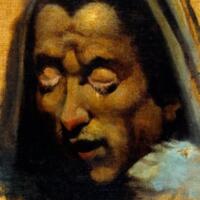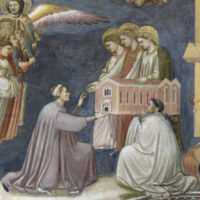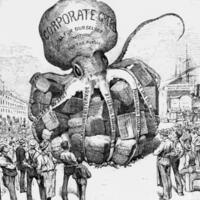Browse Exhibits (47 total)
The Distrust of Wealth in Medieval Italy

Hello and welcome to my exhibit! It focuses on the distrust of the massive wealth acured by different groups.
Throughout the cource of human history, two groups have always existed the haves and the have-nots. The main seperator of these two groups is obviously wealth. Looking specifically at medival Italy it quickly becomes apparent that these groups are made up of both the church as well as other aristocratic, usually merchant focused, families.
It is also apparent that the have-nots often envy those in power and aspire to reach the same socail standing or power. However, others justify the fact that they are have-nots by critizing the means by which the haves came to power. This leads to distrust of the haves by the have-nots.
This exbit focuses on documenting several examples of the misuse of wealth in medival Italy and commentary on that misuse.
Avarice in the Church

Dante's Inferno dealing with the Church
There are many ways two demonstrate criticism or your personal opinion. This exhibit specifically goes into detail on how Dante's Alighieri criticized the Catholic Church through his Commedia. Canto 7 and 9 have a clear connection between avarice and the church, regarding religious figures and those who try to buy their way into heaven is also another historical artifact that details agree the church can be when it comes to the idea of pardoning sins through monetary consumption.
The Greed and Corruption of Ancient Italy

Hello and welcome to my exhibit!
The essence of self-interest is a powerful motivator, influencing people to react out of one's most basic natural instinct, self-preservation and security. Throughout history, many powerful people abroad have been subjected to this mindset of thinking, leading to corruption. Through this corruption, false accusations have been made, wrongfully accused people have suffered, and common folk have lived in misery because top to bottom greed has led people astray from the pathway of compassion and empathy. During the 14-15th century Italy, layers of political and secular corruption have lead to a unique society where the payoff of personal wealth and power is seen as rationalization for greed and dishonesty. In this exhibit, we will explore three pieces that shed a light onto the mass deception and misconduct that often motivated people to desert their morals and values in turn for a slice of power and influence in their society.
Many Italian writers and artists, including poet Dante Alighieri and writer Giovanni Boccaccio, contributed pieces depicting avarice in their current culture. These works lend to a portrayal of the environment as being hostile and distrustful. While serving one’s own desires is important to an extent, when it comes at the cost of harming the public, breaking laws, and crossing ethical lines, only chaos and misery will come in the pursuit of the illusion of success.
Dante’s Life in His Divine Comedy

In this Exhibit, items featuring Dante and his works are analyzed to unpackage the ways he incorporates his own life and experiences in his Divine Comedy. The items featured in this exhibit focus on three significant characters in the comedy that have both ambiguous meanings and a major role in Dante's life: Virgil, Beatrice, and Pope Boniface Viii.
In order to understand which parts of the Divine Comedy were derived from his own life, it is appropriate to first understand the key moments and motives in Dantes life. Dante was born and raised in Florence and started off as a primarily romantic writer. At this time in his life, much of Dante's poetic themes were inspired by who he described as the love of his life: Beatrice. Later, Dante would be exiled from Florence which had fallen to the Black Guelphs under the orders of Pope Boniface VIII. This would spur a dramatic shift in Dante's themes from his traditional romantic writing to themes of avarice and corruption. This is what motivated him to write his Divine Comedy. After his exile Dante would travel throughout Italy, taking refuge in different cities until his death.
In the comedy, Dante explores heaven, hell, and purgatory through the lense of his own experience, even writing himself as the protagonist. This exhibit will utilize context to clarify Dante's use of this lense.
Heavenly Pigments: Public Art and the Evolution of Salvation

Welcome to my exhibit!
Throughout time, art has been used to convey aspects of the human experience and influence the way they interact with the world; from the prehistoric paintings of life found on the walls of French caves to the transformative pieces of art that become symbols of resistance and solidarity during times of violence, art has had a profound impact in shaping human consciousness. Oftentimes the art surrounding a civilization echoes the attitudes towards social factors, such as religion, and this sentiment was heavily seen in the centuries before the High Renaissance, when Early Renaissance painters like Giotto and Medieval writers like Dante and Boccacio were creating their most iconic works. This same sentiment can be seen in the modern era, although its parameters have shifted slightly to fit the attitudes of this day and age.
This exhibit will trace that evolution of salvation through art found in public spaces of various time periods, examining how the concept of salvation echoed the social sentiments of the time and how this concept could be applied to modern times, where public art is used to express salvation for not only oneself, but for systems and people beyond just the self.
Hope you enjoy!
Dante Alighieri and the Sin of Pride
Hello and welcome to my exhibit! Here I will be focusing on the Sin of Pride and what sets it apart from the other Deadly Sins.
Dante's Divine Comedy is an Italian poem that he completed in 1320. It is considered to be one of the most significant literary works in the world. This Italian poem is important because of how impactful it was at the time it was written. It portrayed Dante's vision of life after death. It was so impactful this then inspired many artists for about seven centuries. The Divine Comedy is separated into three parts, the Inferno, Purgatorio, and Paradiso. It is the journey a soul will go through after death. Inferno is the rejection of sin, Purgatorio is the repentance of sin, and finally the soul’s ascent to God in Paradiso. Within the Inferno, there are nine circles of Hell in which Dante discusses of some of the Seven Deadly Sins in each circle. However, he doesn't explicitly mention anything about pride in any of the circles. He instead mentions it in Purgatorio where there are instead seven terraces of Purgatory that represent the Seven Deadly Sins.
Avarice In Dante's Time and Secular Perception

Perceptions of the sin of avarice varied mostly as a result of theological interpretations. Christian teachings were the primary source for the moral beliefs of Dante and those who were near his time in Italy. This exhibit will demonstrate the perception of avarice by Dante and Boccaccio as well as more secular views of avarice in order to provide a contrast.
The Value of Generosity
Hello welcome, all.
In this exhibit, I will be valuing the concept and idea of generosity in medieval Italy. I will be doing so through the lens of famous medieval Italian writer and poet Dante Alighieri. For Dante, I will be focusing on his famous work in The Divine Comedy. I will be narrowing his work by focusing on Inferno's Canto XIX and Paradiso's Canto XI.
Dante Alighieri was born in 1265 in Florence, Italy. Dante was married at the age of 20 and had amassed a comfortable living and great social status. However, due to the political atmosphere in Florence, Dante found himself exiled from the city. Dante's wealth and belongings were seized and he was forced to leave the city. This caused Dante to have bitter sentiments toward the people of Florence and some more than others. During Dante's exile, he started to write one of the world's greatest pieces of literature, The Divine Comedy. The Divine Comedy is split into three major sections: Inferno, Purgatorio, and Paradiso. In Inferno, the main character named Dante finds himself navigating through Hell with the help of his guide, a poet named Virgil. He is on a journey to find meaning in life as he has lost his way. Dante throughout Inferno will grow and learn to face his fears with the help of the sagacious Virgil. The Divine Comedy blends Italian stories, catholic principles, and greek and roman epics to cover a wide variety of topics. Dante criticizes the political atmosphere surrounding Italy, the corruption in both levels of church and state, and questions life itself in The Divine Comedy.
Boccaccio and Gender Roles
Hello and welcome to my exhibit! Here, I will be discussing Giovanni Boccaccio, who was an Italian author from the fourteenth century and is now thought of by some as one of the greatest European prose writers of all time. His pieces of literature, along with Dante’s and Petrarch’s works, two other notable Italian authors, set the scene for what would be defined as Italian literary tradition.
In some of his works, Boccaccio introduced, described, and discussed very radical ideas for his time such as feminism and gender roles. During Boccaccio’s era, these concepts were unheard of to write about and were not as accepted in society as compared to modern times, making Boccaccio’s inclusion of gender roles an interesting and new phenomenon.
In this exhibit, I will be further discussing and analyzing a work in which Boccaccio wrote with a focus on gender roles relating to poverty or wealth, as well as analyze how society responded to Boccaccio’s ideas over time.
Thank you for visiting my exhibit and hope you enjoy!
Written and created by Emma D'cessare
The Ethics Within the Comedy
Canto per Canto: Inferno Canto 11
Catherine Adoyo from George Washington University and Akash Kumar from Indiana University host a discussion upon Inferno Canto 11, of the divine comedy. They elaborate many details of how Dante constructed his levels of hell and how they are assigned in the following Canti.
It is in this canto where Dante-Pilgrim and Virgil first explain how Dante-poets’ values and relationship of politics and community intertwine with his ideas of Philosophy and Ethics.
Within this discussion there is brief mention upon Aristotle`s: Nicomachean ethics as it is true that Dante did model the circles of his inferno to reflect the philosophical statures of Aristotle`s work. It is important to note the influence of Pope Gregory the Great in the 6th century, Albert Magnus (1206-1280) as well as, Saint Thomas Aquinas, (1225-1274) developed the path to lead to Dante’s reconstruction of the themes displayed within his elaboration of morals and ethics.
Aristotle`s work of Nichomachean ethics, is a set of books created from a series of Aristotle’s lectures. The lectures that these books are crafted for, are to teach how to achieve, as put in layman terms “happiness” or eudaimonia.[1]which in direct translation would mean to have a good soul. Dante marries his ideas of how sinners are to be punished for their excessive indulgence in their vices and how Aristotle describes the virtues and acts to have a good soul. Dante pays tribute to Aristotle’s in respect to Aristotle’s idea of sins of extreme, “each moral virtue is mean or lies between extremes of pleasure or of action—doing or feeling too much or too little.”[2] As can be seen in the people whom derive inspiration from this work the theme of contrasting extremes and aspiration toward eudaimonia continues to unfold.
Within the bounds of Dante`s Divine Comedy it is important to acknowledge Pope Gregory the great in the 6th century, his influence is primarily regarding the Seven Deadly Sins and their classifications as this is seen in the first circles of the inferno cantos as they descend simultaneously with their severity. Pope Gregory, intended to inform to the people of the church, to be sensible in their actions as to not evoke desires of the Seven Deadly Sins by doing so he gave forth the list of Lust, Gluttony, Sadness, Avarice, Anger, Envy and Vainglory. As it can be seen in later regard this list is changed as the views of the church are manipulated and altered. The reasoning behind this list and their alterations is due to the seriousness of their offences against love, the altercations to this list can be identified through the views regarding there seriousness as they have changed from the 6th century.
Albert Magnus (1206-1280) was a Dominican Friar; educated in Padua, Italy where his decree of study lay heavily on Aristotle’s writings. He was known in best regards toward his comprehensive knowledge of science in combination with religion. Magnus wrote upon the works of Aristotle; he applied his learnings of philosophy to the ideologies of Christian thought, as well as toward many other fields of study. His work greatly impacted the students that which followed him including Saint Thomas Aquinas. Saint Thomas Aquinas is likely the greatest direct influence upon Dante`s work as he revised the list of the seven deadly sins in the compilation of the “Summa Theologica” with in this list he expels the capital sin of Sadness and replaces it with Sloth and redefines the sin of Vainglory to read as the sin of Pride. Dante uses these definitions and ideologies in his very first interactions with creatures within the inferno. As this direct influence can be seen early on in the cantos, the further influences of the great thinkers that came before him can be seen subtly noted in the cantos that descend in deeper into the depths of Dante`s epic poem The Divine Comedy.
[1] Ross, W.D.trans “The internet Classics Archive:Nicomachean Ethics by Aristotle
[2] Aristotle:Nicomachean Ethics-Gustavus Adolphus College
“Seven Deadly Sins.” Visit the main page. Accessed June 5, 2022. https://www.newworldencyclopedia.org/entry/Seven_Deadly_Sins.
Lafferty, Roger Theodore. “The Philosophy of Dante.” Annual Reports of the Dante Society, no. 30 (1911): 1–34. http://www.jstor.org/stable/40165857.
Thomas. “Summa Theologica, Part I (Prima Pars) by Saint Aquinas Thomas.” Project Gutenberg, January 26, 2006. https://www.gutenberg.org/ebooks/17611.